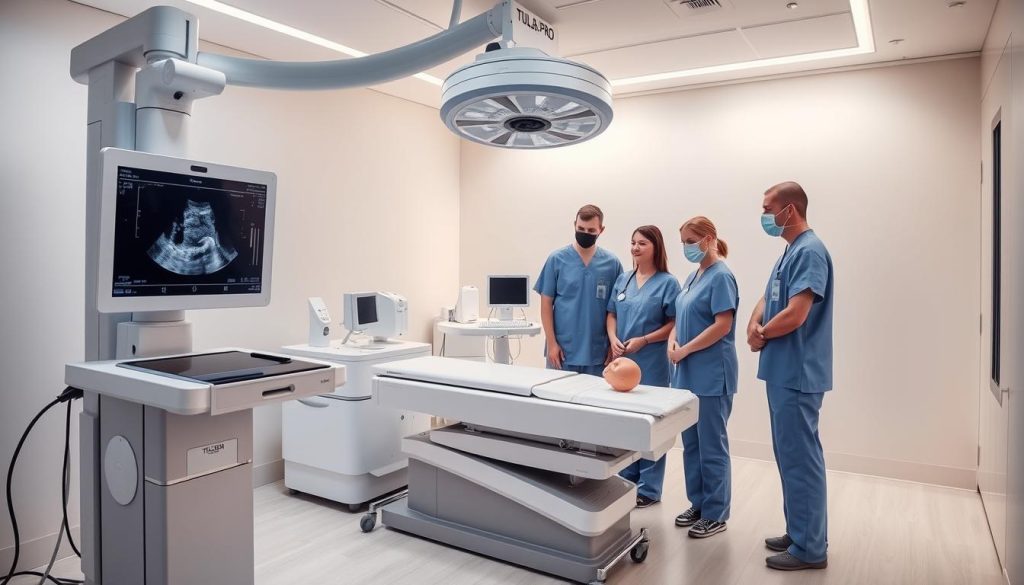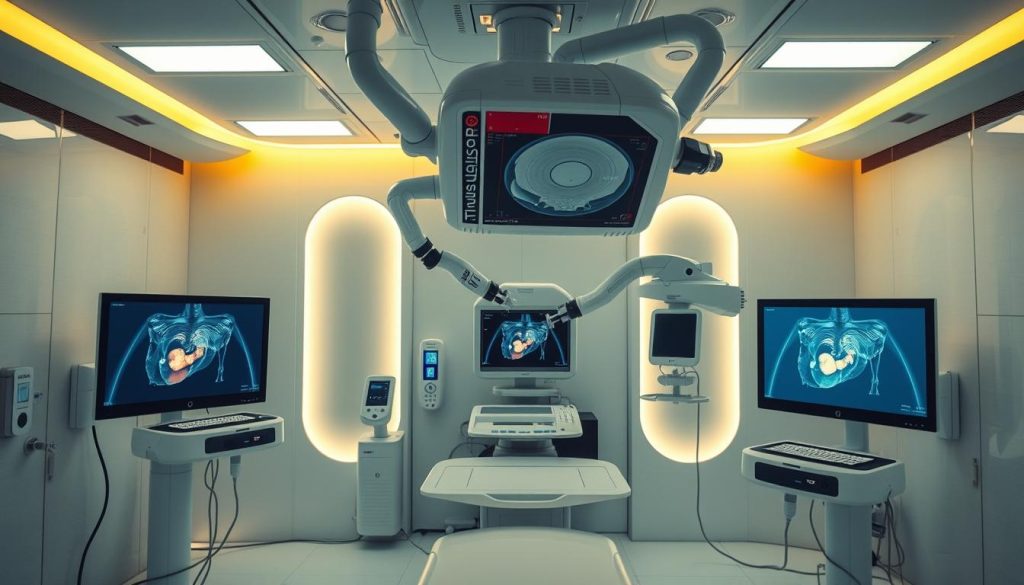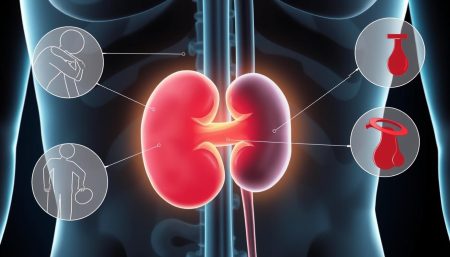A new innovation in prostate cancer treatment is making waves. TULSA-PRO is a beacon of hope for those looking for effective, minimally invasive surgery. It combines ultrasound energy with real-time MRI guidance, opening up new possibilities in urological oncology.
The TULSA-PRO procedure is known for its precision in targeting prostate cancer cells. It uses advanced imaging and energy systems to change prostate cancer care. Let’s explore how it could improve patient outcomes and set new standards in minimally invasive therapy.
Understanding TULSA-PRO Technology in Modern Prostate Cancer Care
TULSA-PRO is a new way to treat prostate cancer. It combines precision and safety. This gives hope to patients looking for effective treatments.
How TULSA-PRO Revolutionary Technology Works
TULSA-PRO uses ultrasound to target prostate cancer. It heats up cancer cells while keeping the healthy parts safe. This method is less invasive, reducing side effects.
Key Components of the TULSA-PRO System
The TULSA-PRO system has important parts:
- Ultrasound applicator: Inserted through the urethra to deliver treatment
- Cooling system: Protects surrounding healthy tissue
- Treatment planning software: Allows for customized therapy plans
- Real-time temperature monitoring: Ensures precise energy delivery
These parts work together for a personalized treatment plan.
Integration with MRI Imaging Technology
TULSA-PRO uses MRI technology. This lets doctors see the prostate gland in real-time. They can adjust the treatment as needed.
This technology is a big step in prostate cancer care. It offers a precise and customizable treatment option. This is a promising alternative to traditional methods.
Is TULSA-PRO the Latest Procedure for Prostate Cancer
TULSA-PRO is a new way to treat prostate cancer. It’s known for its accuracy and could change how we manage prostate health. The FDA approved it in 2019, making it a new tool in fighting prostate cancer.

Medical centers are starting to use TULSA-PRO more. It’s becoming a popular choice for men looking for new treatments. This method aims to treat cancer well while keeping quality of life high.
“TULSA-PRO represents a significant leap forward in our ability to treat prostate cancer with precision and minimal invasiveness,” says Dr. James Smith, a leading urologist at Memorial Cancer Institute.
It’s important to know where TULSA-PRO fits in with other treatments:
| Treatment | FDA Approval | Invasiveness | Recovery Time |
|---|---|---|---|
| TULSA-PRO | 2019 | Minimally invasive | 1-2 weeks |
| Robotic Surgery | 2000 | Invasive | 4-6 weeks |
| Radiation Therapy | 1950s | Non-invasive | Varies |
TULSA-PRO uses MRI and ultrasound to target cancer precisely. As more people try it, it’s becoming a top choice for those who want to fight cancer and keep their prostate healthy.
Benefits of TULSA-PRO Over Traditional Treatment Methods
TULSA-PRO is a breakthrough in prostate cancer treatment. It offers big advantages over old methods, making it a top choice for many.
Precision and Accuracy in Targeting Cancer Cells
TULSA-PRO is great at finding and hitting cancer cells with high precision. It uses MRI to guide doctors, so they can target tumors well and avoid healthy tissue. This is a big step up in treating prostate cancer without a lot of damage.
Reduced Risk of Side Effects
One big plus of TULSA-PRO is it has fewer side effects than old treatments. Because it’s so precise, it causes less harm to nearby areas. This could mean:
- Less chance of losing bladder control
- Lower risk of trouble getting an erection
- Less impact on bowel function
Faster Recovery Times for Patients
TULSA-PRO’s less invasive method means patients heal faster. Most can go home the same day and get back to normal in a week. This is much quicker than the recovery times of old treatments.
| Treatment Aspect | TULSA-PRO | Traditional Methods |
|---|---|---|
| Precision | High (MRI-guided) | Variable |
| Side Effects Risk | Lower | Higher |
| Recovery Time | Days to weeks | Weeks to months |
| Invasiveness | Minimally invasive | Often more invasive |
The TULSA-PRO Treatment Process: From Diagnosis to Recovery
The TULSA-PRO procedure is a new way to treat prostate cancer. It uses the latest technology and focuses on each patient’s needs. This ensures the best results for those fighting cancer.

First, doctors do a detailed check to find out what’s wrong. They use special imaging to see the tumor clearly. This helps them understand the cancer’s size and location.
After the check-up, a treatment plan is made just for the patient. The TULSA-PRO treatment is done in one session. It uses MRI to target the cancer without harming healthy parts.
Recovering from the treatment is often faster than other methods. Most patients feel little pain and can go home the same day. Doctors then keep an eye on how they’re doing to make sure they heal well.
| Stage | Description | Duration |
|---|---|---|
| Diagnosis | Imaging and assessment | 1-2 weeks |
| Treatment Planning | Customized strategy development | 1-3 days |
| TULSA-PRO Procedure | MRI-guided therapy | 3-4 hours |
| Initial Recovery | Post-procedure monitoring | 4-6 hours |
| Follow-up Care | Regular check-ups and assessments | 3-6 months |
The TULSA-PRO procedure is a big step forward in treating prostate cancer. It’s a less invasive option with good results. As medicine keeps getting better, this method will keep helping patients in new ways.
Patient Eligibility and Selection Criteria for TULSA-PRO Treatment
Finding the right patients for TULSA-PRO is key in prostate cancer treatment. This new method of cancer management needs careful selection to get the best results.
Ideal Candidates for the Procedure
TULSA-PRO is best for men with early prostate cancer. The best candidates usually have:
- Prostate-specific antigen (PSA) levels under 15 ng/mL
- Gleason scores of 7 or lower
- Prostate glands smaller than 50 cc in volume
Pre-Treatment Evaluation Process
Before TULSA-PRO, patients undergo a detailed check-up. This includes:
- Detailed medical history review
- Physical examination
- Imaging studies (MRI, CT scan)
- Prostate biopsy results analysis
Contraindications and Limitations
Even though TULSA-PRO has many benefits, it’s not for everyone. Reasons for not being eligible include:
- Advanced or metastatic prostate cancer
- Previous radiation therapy to the pelvic area
- Certain medical implants incompatible with MRI
Knowing these criteria helps both patients and doctors make better choices. Each situation is different, and personalized cancer management is crucial for the best care.
Clinical Studies and Success Rates of TULSA-PRO
The TULSA-PRO system has shown promising results in clinical studies. It is a focal therapy for prostate cancer treatment. Research shows high success rates in controlling cancer with minimal side effects.
In a pivotal study, 96% of patients saw a significant drop in prostate-specific antigen (PSA) levels after treatment.
Patient satisfaction rates are high, with many reporting better quality of life after the procedure. The success rate of TULSA-PRO in preserving urinary continence and erectile function is better than traditional treatments. This is key for men looking for effective treatment without affecting their daily lives.
Compared to other focal therapy options, TULSA-PRO is more precise in targeting cancerous tissue. The use of real-time MRI guidance ensures accurate treatment delivery. This minimizes damage to healthy surrounding structures. As more data comes in, TULSA-PRO is becoming a solid option for prostate cancer patients.
FAQ
Q: What is TULSA-PRO and how does it work?
A: TULSA-PRO is a new way to treat prostate cancer. It uses ultrasound and MRI to find and kill cancer cells in the prostate. This method is precise and doesn’t harm much of the healthy tissue around it.
Q: Is TULSA-PRO truly the latest procedure for prostate cancer?
A: Yes, TULSA-PRO is a recent breakthrough in prostate cancer treatment. It’s approved by the FDA and used by top hospitals. Its unique blend of precision and minimal invasiveness makes it a leading choice in prostate cancer care.
Q: What are the main benefits of TULSA-PRO compared to traditional treatments?
A: TULSA-PRO offers better precision in treating cancer, less chance of side effects, and quicker recovery. It’s a less invasive surgery, leading to less pain and shorter hospital stays than traditional prostatectomy.
Q: Who is an ideal candidate for TULSA-PRO treatment?
A: Men with early prostate cancer are best suited for TULSA-PRO. Your doctor will check your prostate size, cancer stage, and health before deciding if you’re a good candidate.
Q: What does the TULSA-PRO treatment process involve?
A: First, you’ll get a detailed diagnosis and treatment plan. On treatment day, you’ll have MRI-guided ultrasound ablation, which takes a few hours. After, you’ll have a short recovery before going home. Follow-up visits are needed to check on your health.
Q: Are there any limitations or contraindications for TULSA-PRO?
A: TULSA-PRO might not work for everyone. It’s not for those with very large prostates, certain implants, or advanced cancer. Your doctor will check if it’s right for you.
Q: What do clinical studies say about the success rates of TULSA-PRO?
A: Studies show TULSA-PRO is effective in controlling cancer and improving quality of life. It has high success rates and low side effects. But, success can vary, and more data is needed to compare it with other treatments.


















